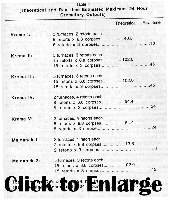

CREMATORIES
 The
crematories utilized at the inspected German facilities were of the older
type. They were constructed of red brick and mortar and lined with a refractory
brick. All of the ovens had multiple retorts, some were blowered (although
none had direct combustion), none had afterburners and all were coke fired
except one facility no longer in existence at Majdanek. None of the retorts
inspected and examined at all of the locations were designed for multiple
corpse incineration. It should be noted that unless specifically designed
for a greater bone to flesh to heat ratio, the retort will not consume
the materials placed within it. Theoretical and real-time estimated maximum
24 hour outputs, based on one (1) corpse per retort per cremation are found
in Table II.
The
crematories utilized at the inspected German facilities were of the older
type. They were constructed of red brick and mortar and lined with a refractory
brick. All of the ovens had multiple retorts, some were blowered (although
none had direct combustion), none had afterburners and all were coke fired
except one facility no longer in existence at Majdanek. None of the retorts
inspected and examined at all of the locations were designed for multiple
corpse incineration. It should be noted that unless specifically designed
for a greater bone to flesh to heat ratio, the retort will not consume
the materials placed within it. Theoretical and real-time estimated maximum
24 hour outputs, based on one (1) corpse per retort per cremation are found
in Table II.
This report is taken from the Zundelsite

|
|